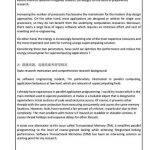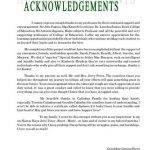STRUCTURE
How to structure the Research Limitations section of your dissertation
There is no “one best way” to structure the Research Limitations section of your dissertation. However, we recommend a structure based on three moves. the announcing. reflecting and forward looking move. The announcing move immediately allows you to identify the limitations of your dissertation and explain how important each of these limitations is. The reflecting move provides greater depth, helping to explain the nature of the limitations and justify the choices that you made during the research process. Finally, the forward looking move enables you to suggest how such limitations could be overcome in future. The collective aim of these three moves is to help you walk the reader through your Research Limitations section in a succinct and structured way. This will make it clear to the reader that you recognise the limitations of your own research, that you understand why such factors are limitations, and can point to ways of combating these limitations if future research was carried out. This article explains what should be included in each of these three moves :
There are many possible limitations that your research may have faced. However, is not necessary for you to discuss all of these limitations in your Research Limitations section. After all, you are not writing a 2000 word critical review of the limitations of your dissertation, just a 200-500 word critique that is only one section long (i.e. the Research Limitations section within your Conclusions chapter). Therefore, in this first announcing move. we would recommend that you identify only those limitations that had the greatest potential impact on: (a) the quality of your findings; and (b) your ability to effectively answer your research questions and/or hypotheses.
We use the word potential impact because we often do not know the degree to which different factors limited our findings or our ability to effectively answer our research questions and/or hypotheses. For example, we know that when adopting a quantitative research design, a failure to use a probability sampling technique significantly limits our ability to make broader generalisations from our results (i.e. our ability to make statistical inferences from our sample to the population being studied). However, the degree to which this reduces the quality of our findings is a matter of debate. Also, whilst the lack of a probability sampling technique when using a quantitative research design is a very obvious example of a research limitation, other limitations are far less clear. Therefore, the key point is to focus on those limitations that you feel had the greatest impact on your findings, as well as your ability to effectively answer your research questions and/or hypotheses.
Overall, the announcing move should be around 10-20% of the total word count of the Research Limitations section.
Having identified the most important limitations to your dissertation in the announcing move.
the reflecting move focuses on explaining the nature of these limitations and justifying the choices that you made during the research process. This part should be around 60-70% of the total word count of the Research Limitations section.
It is important to remember at this stage that all research suffers from limitations, whether it is performed by undergraduate and master’s level dissertation students, or seasoned academics. Acknowledging such limitations should not be viewed as a weakness, highlighting to the person marking your work the reasons why you should receive a lower grade. Instead, the reader is more likely to accept that you recognise the limitations of your own research if you write a high quality reflecting move. This is because explaining the limitations of your research and justifying the choices you made during the dissertation process demonstrates the command that you had over your research.
We talk about explaining the nature of the limitations in your dissertation because such limitations are highly research specific. Let’s take the example of potential limitations to your sampling strategy. Whilst you may have a number of potential limitations in sampling strategy, let’s focus on the lack of probability sampling ; that is, of all the different types of sampling technique that you could have used [see Types of probability sampling and Types of non-probability sampling ], you choose not to use a probability sampling technique (e.g. simple random sampling. systematic random sampling. stratified random sampling ). As mentioned, if you used a quantitative research design in your dissertation, the lack of probability sampling is an important, obvious limitation to your research. This is because it prevents you from making generalisations about the population you are studying (e.g. Facebook usage at a single university of 20,000 students) from the data you have collected (e.g. a survey of 400 students at the same university). Since an important component of quantitative research is such generalisation, this is a clear limitation. However, the lack of a probability sampling technique is not viewed as a limitation if you used a qualitative research design. In qualitative research designs, a non-probability sampling technique is typically selected over a probability sampling technique.
And this is just part of the puzzle?
Even if you used a quantitative research design, but failed to employ a probability sampling technique, there are still many perfectly justifiable reasons why you could have made such a choice. For example, it may have been impossible (or near on impossible) to get a list of the population you were studying (e.g. a list of all the 20,000 students at the single university you were interested in). Since probability sampling is only possible when we have such a list, the lack of such a list or inability to attain such a list is a perfectly justifiable reason for not using a probability sampling technique; even if such a technique is the ideal.
As such, the purpose of all the guides we have written on research limitations is to help you: (a) explain the nature of the limitations in your dissertation; and (b) justify the choices you made.
In helping you to justifying the choices that you made, these articles explain not only when something is, in theory. an obvious limitation, but how, in practice. such a limitation was not necessarily so damaging to the quality of your dissertation. This should significantly strengthen the quality of your Research Limitations section.
Finally, the forward looking move builds on the reflecting move by suggesting how the limitations you have discuss could be overcome through future research. Whilst a lot could be written in this part of the Research Limitations section, we would recommend that it is only around 10-20% of the total word count for this section.





 Optical properties of nanoparticles thesis proposal
Optical properties of nanoparticles thesis proposal Remove 0 comments thesis proposal
Remove 0 comments thesis proposal 3d virtual tour thesis proposal
3d virtual tour thesis proposal Master dissertation proposal sample uk customs
Master dissertation proposal sample uk customs Dissertation proposal sample business cards
Dissertation proposal sample business cards






